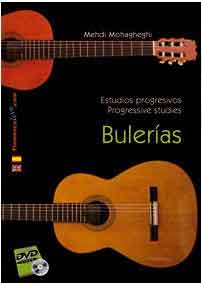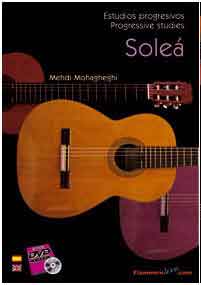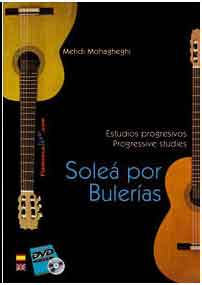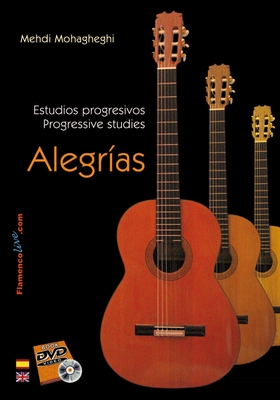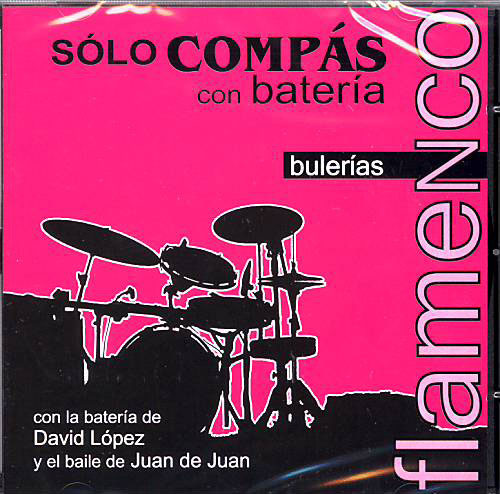- 🚚 📦 WORLDWIDE SHIPPING ✈️ 🌍
Bulerías. Progressive studies for Flamenco Guitar by Mehdi Mohagheghi
Bulerías pregressive studies.
Series of 51 Bulerías studies for flamenco guitar, suitable for all levels. Measures and falsetas (variations) are gradually studied, reaching the right level to play falsetas of the artist like Paco de Lucía, Moraito, Manuel Granados... Once you dominate all the studies, you will be able to play your own pieces mixing different falsetas studied in this Dvd.
Book/DVD CONTENTS:
Bulerías.
Phrygian Mode
Study 1: The first 6 beats
Study 2: Another variation of the first 6 beats
Study 3: Another variation of the first 6 beats
Study 4: A complete “compás”
Study 5: An example with two complete “compás”
Study 6: An example of beats 10-11-12 used for joining one “compás” to the next
Study 7: Another example of beats 10-11-12 used for joining one “compás” to the next
Study 8: An example of one complete “compás”
Study 9: An example of one complete “compás”
Study 10: Another example, ending with Rasgueo
Study 11: Another example
Study 12: Another example
Study 13: A complete “compás” using a phrase leading to the note "A" on the beat 10. ( Leading Phrase)
Study 14: Another example of the " leading phrase"
Study 15: Another example of the " leading phrase"
Study 16: Another example of the " leading phrase"
Study 17: Another example of the " leading phrase"
Study 18: Another example of the " leading phrase"
Study 19: Another example of the " leading phrase"
Study 20: Another example of the " leading phrase"
Study 21: An example beginning with beat 1
Study 22: Llamada ending on the beat 10.(suitable for playing before falsetas beginning on beats 11 or 12 or 1)
Study 23: Another example of a llamada ending on the beat 10
Study 24: Llamada ending on the beat 6.(suitable for playing before falsetas beginning on the beats 9 or 10 or in between)
Study 25: An example of a rhythmic sentence to change the mode from "A phrygian" to "A minor"
Minor Mode
Study 26: A complete “compás” in "A" minor
Study 27: Another example
Study 28: Another example
Study 29: An example of two complete “compás”
Study 30: A complete “compás” using a phrase leading to the note "A" on the beat 10. ( Leading Phrase)
Study 31: Another example of the " leading phrase"
Study 32: An example of beats 10-11-12 used for joining one “compás” to the next
Study 33: Another example of beats 10-11-12 used for joining one “compás” to the next
Ending
Study 34: An ending for Buleria in "A Phrygian"
Study 35: An ending for Buleria in "A minor"
Falsetas in Phrygian Mode:
Falseta 1: A falseta that can be used as an introduction, Gerardo Núñez
Falseta 2: Another falseta that can be used as an introduction, Paco Cepero
Falseta 3: A traditional falseta using the thumb, Manuel Granados
Falseta 4: Paco Peña falseta
Falseta 5: Paco de Lucía falseta
Falseta 6: Paco de Lucía falseta
Falseta 7: A falseta that starts between beats 9 and 10(with the 6-beat llamada), Moraito
Falseta 8: A traditional falseta using Picados , Alzapuas and Rasgueos. Paco Peña
Falseta 9: A falseta originally used in cante accompaniment, Paco de Lucía
Falseta 10: A falseta that starts on the beat 1, Paco de Lucía
Falseta 11: A very popular falseta, Paco de Lucía
Falseta 12: A modern falseta using arpegios, Paco de Lucía
Falsetas in A Minor:
Falseta 13: A falseta using the thumb, Mehdi Mohagheghi
Falseta 14: A traditional falseta using Picados, Paco Peña
Falseta 15: A modern falseta using the thumb, Rafael Cortés
Falseta 16: A very popular falseta using picados, Paco de Lucia
Bulerías pregressive studies.
Series of 51 Bulerías studies for flamenco guitar, suitable for all levels. Measures and falsetas (variations) are gradually studied, reaching the right level to play falsetas of the artist like Paco de Lucía, Moraito, Manuel Granados... Once you dominate all the studies, you will be able to play your own pieces mixing different falsetas studied in this Dvd.
Book/DVD CONTENTS:
Bulerías.
Phrygian Mode
Study 1: The first 6 beats
Study 2: Another variation of the first 6 beats
Study 3: Another variation of the first 6 beats
Study 4: A complete “compás”
Study 5: An example with two complete “compás”
Study 6: An example of beats 10-11-12 used for joining one “compás” to the next
Study 7: Another example of beats 10-11-12 used for joining one “compás” to the next
Study 8: An example of one complete “compás”
Study 9: An example of one complete “compás”
Study 10: Another example, ending with Rasgueo
Study 11: Another example
Study 12: Another example
Study 13: A complete “compás” using a phrase leading to the note "A" on the beat 10. ( Leading Phrase)
Study 14: Another example of the " leading phrase"
Study 15: Another example of the " leading phrase"
Study 16: Another example of the " leading phrase"
Study 17: Another example of the " leading phrase"
Study 18: Another example of the " leading phrase"
Study 19: Another example of the " leading phrase"
Study 20: Another example of the " leading phrase"
Study 21: An example beginning with beat 1
Study 22: Llamada ending on the beat 10.(suitable for playing before falsetas beginning on beats 11 or 12 or 1)
Study 23: Another example of a llamada ending on the beat 10
Study 24: Llamada ending on the beat 6.(suitable for playing before falsetas beginning on the beats 9 or 10 or in between)
Study 25: An example of a rhythmic sentence to change the mode from "A phrygian" to "A minor"
Minor Mode
Study 26: A complete “compás” in "A" minor
Study 27: Another example
Study 28: Another example
Study 29: An example of two complete “compás”
Study 30: A complete “compás” using a phrase leading to the note "A" on the beat 10. ( Leading Phrase)
Study 31: Another example of the " leading phrase"
Study 32: An example of beats 10-11-12 used for joining one “compás” to the next
Study 33: Another example of beats 10-11-12 used for joining one “compás” to the next
Ending
Study 34: An ending for Buleria in "A Phrygian"
Study 35: An ending for Buleria in "A minor"
Falsetas in Phrygian Mode:
Falseta 1: A falseta that can be used as an introduction, Gerardo Núñez
Falseta 2: Another falseta that can be used as an introduction, Paco Cepero
Falseta 3: A traditional falseta using the thumb, Manuel Granados
Falseta 4: Paco Peña falseta
Falseta 5: Paco de Lucía falseta
Falseta 6: Paco de Lucía falseta
Falseta 7: A falseta that starts between beats 9 and 10(with the 6-beat llamada), Moraito
Falseta 8: A traditional falseta using Picados , Alzapuas and Rasgueos. Paco Peña
Falseta 9: A falseta originally used in cante accompaniment, Paco de Lucía
Falseta 10: A falseta that starts on the beat 1, Paco de Lucía
Falseta 11: A very popular falseta, Paco de Lucía
Falseta 12: A modern falseta using arpegios, Paco de Lucía
Falsetas in A Minor:
Falseta 13: A falseta using the thumb, Mehdi Mohagheghi
Falseta 14: A traditional falseta using Picados, Paco Peña
Falseta 15: A modern falseta using the thumb, Rafael Cortés
Falseta 16: A very popular falseta using picados, Paco de Lucia












